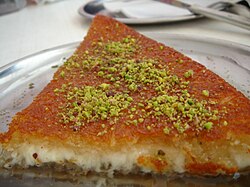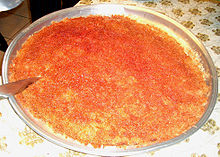Knafeh
 | |
| Typ | Dessert |
|---|---|
Kenafeh (Arabic: كنافة kanāfah), also spelled knafeh, kunafeh, or kunafah, is an Arab cheese pastry soaked in sweet syrup.[1]
Preparation

Kanafeh pastry comes in three types:
- khishnah (Arabic خشنه) (rough) - crust made from long thin noodle threads;
- na'ama (Arabic ناعمة) (fine) - semolina dough;
- mhayara (Arabic محيرة) (confused) - a mixture of khishnah and na'ama.
The pastry is heated with butter, margarine or palm oil, then spread with soft white cheese such as Nabulsi cheese, and topped with more pastry. In khishnah kanafeh the pastry is rolled around the cheese. A thick syrup of sugar, water and a few drops of Rose water or orange blossom water is poured on the pastry during the final minutes of cooking. Often the top layer of pastry is tinted with orange food coloring. Crushed green pistachios are sprinkled on top as a garnish.
The city of Nablus is especially renowned for its kanafeh.[2]
Jerusalem kanafeh is a neon orange pastry with a crust of shredded phyllo dough or semolina filled with soft goat cheese and drenched in syrup. It is especially popular during Ramadan.
Variants


Ka'ket Kanafeh
This variant is popular across the Levant and Turkey, where it can be eaten for breakfast or even for dinner as a main meal; but it is primarily considered a dessert. Eaten as a layered treat or helwah[clarification needed], it may also be placed in a special bread[which?] and sprinkled with sesame seeds. It is traditionally served alongside, or drenched in, a thick, sugar-based, honey-based, or glucose-based syrup called qattar or attar.
Kadayıf and Künefe
The Turkish variant of the pastry kanafeh is called künefe, and the bunch of wirey shreds that it is based on is called kadayıf. A semi-soft cheese such as mozzarella is used in the filling.[3] In making the künefe, the kadayıf is not rolled around the cheese; instead, cheese is put in between two layers of wire kadayıf. This is cooked in small copper plates, and then served very hot, in syrup, with clotted cream (kaymak), and pistachios or walnuts. (Compare with kadaif.)
Kadaif
In this variant, called also καταϊφι or κανταϊφι in Greek (kataïfi or kadaïfi), the threads are used to make pastries of various forms (tubes or nests), often with a filling of chopped nuts, like that used for baklava. A kadaif pastry is made by putting down a layer of wire kadaif, then a layer of a filling of chopped nuts, then another layer of wire kadaif. The pastries are painted with melted butter, baked until golden brown, then drenched in sugar or honey syrup.[4]
World records
The largest plate of kanafeh was made in Nablus[5] in an attempt to win a Palestinian citation in the Guinness World Records. It measured 75×2 meters and weighed 1,350 kilograms.
See also
{{{inline}}}
- Phyllo
- Qatayef, a dumpling-like confection involving some of the same ingredients
- Ekmek kadayıfı, Turkish bread custard
References
- ^ Sahar Khalifeh (2008). The End of Spring (Paperback ed.). Interlink Books. p. 277. ISBN 1566566819.
- ^ Cuisine Institute for Middle East Understanding.
- ^ http://www.politikcity.de/forum/internationale-k%FCche-d%FCnyanin-mutfa/19192-k%FCnefe.html
- ^ http://www.kuhar.ba/recepti/deserti/kadaif/
- ^ WEST BANK: Palestinian Knafeh enters Guinness World Records.
